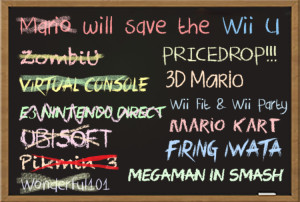Xbone’s Long Term Trajectory “Hasn’t Changed at all”
The past week has seen the unveiling of Xbox Fitness, a subscription based app that streams popular workout routines, and monitors one’s physiological data via Kinect. Microsoft may well have confounded some of their more dim-witted Xbots into embracing the Xbone by dint of their half-hearted backpedaling attempts in the wake of their poorly received Xbone unveiling – yet as Microsoft’s marketing machine shifts into full-swing ahead of the console’s November [limited] release, it is becoming ever more apparent where the console’s true focus lies. Every week a new Xbone advert or service surfaces, and every week it has very little to do with gaming. Microsoft are positioning the Xbone as a mass market consumer item where gaming merely serves as a tertiary function. Amusingly, Microsoft will swear until they are blue in the face that they are all about gaming when speaking to the enthusiast gaming press, yet when talking to industry news sources the Xbone’s gaming chops are downplayed to one of several features.
Given the Xbone marketing’s lack of interest in promoting gaming, it should come as absolutely no surprise to any reasonable gamer that Microsoft’s Phil Harrison has absolutely no qualms in confirming that the Xbone’s “long term vision hasn’t changed at all“.
“We haven’t diluted our long term vision, which is all of the benefits of a connected ecosystem and what that means for all of the stakeholders – us, developer, publisher and crucially, the player. None of that has changed. What we recognised was when you put a disc slot in the front of a machine certain expectations come with that disc slot. We had to adapt some of our policies and it was best that we did those before we launched, which we’ve done. All of that can be handled in the vacuum of the pre-launch activity. And it allows the players to have a choice. They can consume the content through the medium they like the best and fits with their particular situation. I don’t think there’s a negative to that.”
Microsoft may have done away with unpopular measures such as the always on DRM requirement, but their vision for the console going forward will nonetheless see it become, first and foremost, a media streaming device which seeks to replace physical media ownership with digital licenses. Indeed, Harrison even appears to bridle at the notion that digital games should cost less than physical ones on account of fewer distribution costs and more favourable margins. When asked why digital products were not cheaper to buy than boxed ones, Harrison suggested that digital products only seemed expensive because the physical point of comparison exists, which is an obstacle that Microsoft are keen to remove:
“You could take that point of view. But you could also take the point of view that the only way in which our industry can continue to grow is if the margin structure enriches game development. Meaning that as much as the consumer spend as possible accrues back to the creator. Striking a balance between those two extremes is going to be tricky. Particularly when you have this direct A-B comparison of Tesco selling a packaged version of the game and an online service selling the digital version of exactly the same bits and the pricing is easily comparable. What we’re seeing is a trend where new business models that are going to exist only online are going to potentially be the ones that last the longest. Look at some of the free-to-play investments that we’re making on Xbox 360 with World of Tanks and Warface. They won’t be retailer experiences, they will be digital experiences, you won’t have that direct A-B comparison.”
Microsoft continues to position itself into an awkward market segment – people who want a multimedia delivery platform that can also make a decent fist of functioning as a games console. The awkwardness comes from the fact that the Xbone’s five hundred dollar price-tag is presumably too expensive for people looking for a media streaming hub, while the fact that the Xbone is both weaker and more expensive than the PS4 makes it a less attractive proposition to console early adopters. It is possible that this curious direction may still pan out for Microsoft once the console’s pricing becomes more affordable in several years time, yet it seems assuredly the case that this strategy will see Sony’s PS4 pull ahead of the Xbone during the early stages of the eighth console generation.
Valve Makes Three Anticipated Announcements, with Mixed Results
Valve’s heavily rumoured ‘Steam Box’ PC console has been one of the worst kept secrets of the game industry, with Valve themselves making no real efforts to keep the project under wraps. This week saw the unveiling of Valve’s plans to bridge the divide between PC and console gaming – and the results were decidedly mixed. Valve first announced a free Linux-based operating system called SteamOS, followed by multiple hardware configurations which are set to debut in 2014. Valve will partner with multiple manufacturers to deliver a rumoured ten different Steam Boxes, and 300 gamers will get the opportunity to beta-test the new hardware later this year, contingent upon their meeting certain criteria.
So far, so good – though gamers should avoid setting their expectations too high. Only a tiny fraction of Steam titles are currently compatible with Valve’s new operating system. The company has been touting the ability for users of SteamOS to stream incompatible games from their Windows PC to their Steam Box, yet this feature seems a tad redundant seeing as the scenario would require that the prospective Steam Box owner have access to a gaming PC also. Moreover, Linux is currently said to be incompatible with Netflix, owing to the service’s use of Microsoft software to stream videos, which serves to further lessen the appeal of adopting a Steam Box as the livingroom’s primary media hub. Then again, these teething problems are things that will likely be remedied with time.
And then Valve made their third and final announcement… A new PC gamepad so ridiculous and unintuitive that one is almost certain that they hired on former Nintendo hardware designers. In short, Valve have managed to create the least useful controller that anyone could ever hope to use for most existing genres. Valve has opted to feature two circular trackpads in the place of thumbsticks, along with a tiny touchscreen [not dissimilar to the one utilised by the Dualshock 4] which occupies the center of the controller, around which is located the gamepad’s triangular face buttons – on both sides of it! Missing from the controller is any form of dpad, so have fun negotiating game menus exclusively via touchscreen. Allegedly, the design philosophy surrounding the controller was to create something that allowed game genres which would usually be incompatible with gamepads [such as RTS] to be played from the comfort of the couch. To be fair, Valve have probably been successful in achieving this aim, yet in so doing they have designed a controller which looks to be fundamentally dreadful to use for any established genre which is traditionally best suited to a gamepad.
“Traditional gamepads force us to accept compromises. We’ve made it a goal to improve upon the resolution and fidelity of input that’s possible with those devices. The Steam controller offers a new and, we believe, vastly superior control scheme, all while enabling you to play from the comfort of your sofa. Built with high-precision input technologies and focused on low-latency performance, the Steam controller is just what the living-room ordered.”
Congratulations, Valve. One never expected the Wiimote to ever be surpassed in terms of awfulness, yet somehow the new Steam controller has managed the seeming impossible. If Valve wishes to enter the console space with their own hardware – and have that hardware thrive – then they would be best served by going back to the drawing board, and designing something a tad more usable.
Nintendo Face Threat of Disappearing Altogether from UK Retail
Multiple anecdotal accounts have surfaced this week that Nintendo games have all but disappeared from Tesco, the UK’s largest supermarket retailer. Nintendo games had been previously allowed their own discrete shelf-space, yet now they have been downsized and glommed on to the Xbox 360 shelves, and allowed a meager top-5 display – across all four currently supported Nintendo consoles!
This story obviously follows on from the news that both ASDA and Morrisons have completely withdrawn support from the Wii U in their stores. To be fair, the retail gaming displays supported by major UK supermarkets has allegedly been shrinking across the board recently, yet the shelf-space offered to the Xbox 360 and PS3 is still said to be substantial, so there is little question that Nintendo’s vanishing presence at retail is a disproportional occurrence.
It is no surprise as to why Nintendo is disappearing from UK retail. During the last quarter the Wii U only managed to 160,000 consoles across all of Europe, and only a fraction of that within the UK. Meanwhile, UK supermarkets were finding themselves unable to shift Wii U consoles even after cutting their price in half. Many people have expressed wonder at the fact that the 3DS has been treated in a similar fashion to the Wii U, yet surprisingly January to August of 2013 has seen the 3DS outperformed by the PC to the tune of almost 600,000 fewer games sold – and of course the Xbox 360 and PS3 outperformed it by an exponentially greater margin again. It is not clear where Nintendo is to go to from here, but the evidence suggests that they have already lost the UK for an entire generation.


